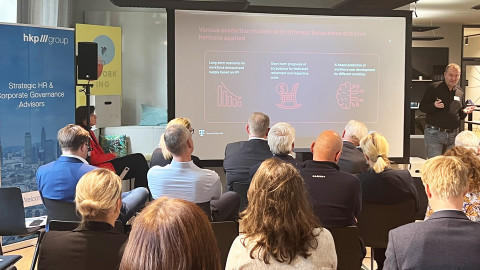Corporate Governance & Board Compensation

hkp.com in conversation with Corporate Governance Advisor Dr. Pia Lünstroth
ATX: Sustainability in Supervisory Board and Management Board Compensation
What do the voting guidelines of leading ATX investors and proxy advisors say about the implementation of sustainability in management and supervisory board compensation? hkp.com talked to Corporate Governance Advisor Dr. Pia Lünstroth. read more ...

An article by Phil Johnson and Tara Tays from Pay Governance
The Intersection Of ESG And Executive Incentive Plans
More and more companies are integrating ESG goals into executive incentive plans. Phil Johnson and Tara Tays from Pay Governance, our partner for North America and Asia, report on how this is being done in a compact article. read more ...
Digitalization, Start-ups & IT-Tools

Update zur Umfrage des Bundesverbands für Personalmanager BPM & Ethikbeirat HR-Tech
Employee representatives view the use of AI in HR with a certain amount of skepticis
Co-determination side and HR are equally in favor of clear ethical frameworks in the use of AI and modern technologies. Update on the survey by the German Association for Human Resource Managers BPM & Ethics Advisory Board HR-Tech. read more ...

Peter Dodell from Siemens Energy and hkp/// group Partner Holger Jungk interviewed by hkp.com
Siemens Energy: proprietary IT infrastructure for Comp & Ben
Why do some people prefer standard HR IT solutions and others new systems? HR IT experts Holger Jungk, hkp/// group, and Peter Dodell from Siemens Energy talked to hkp.com. read more ...
Compensation & Benefits, Grading

Oliver Baierl, a high-profile HR and regulatory expert from the financial sector, joins hkp///group
hkp/// group strengthens strategic HR consulting
hkp///group appointed Oliver Baierl as its new Senior Director on October 1st, 2023. He joins from KfW Bankengruppe, where he has held various positions since May 2015 – most recently as Head of Compensation & Benefits. read more ...

An interview with Barry Kitz and David Voggeser
Long-term Incentives in times of economic crisis
Multi-year share-based variable compensation is facing key challenges in the wake of multiple crisis. Barry Kitz and David Voggeser discuss options for action in times of economic uncertainty. read more ...
Performance & Compensation Benchmarking

Johannes Brinkkötter and Petra Knab-Hägele on findings from the hkp// group Transformation Lab
Delivering a clear vision: HR in the transformation driver’s seat
The hkp/// group Transformation Lab recently brought together HR managers for an exchange on aspects of building, dismantling and transforming companies. A conversation about learnings and experiences. read more ...

hkp/// group Workforce Insights Snippets, Part 2
Top executive and non-tariff employee quotas in Germany
What proportion of employees do non-tariff employees make up in terms of different functional areas and industries? Part 2 of the hkp/// group Workforce & Compensation Insights with compensation experts Verena Vandervelt and Sabrina Müsel. read more ...
HR Strategy & Transformation

Change-experienced HR and communications expert joins hkp/// group as Senior Director
Patrick Maloney strengthens strategy and transformation consulting at hkp/// group
Effective December 1, 2023, Patrick Maloney joins hkp/// group, a management consultancy specializing in strategic HR management and corporate governance, as a new Senior Director. read more ...

An interview with Peter Dodell, Siemens Energy, and David Voggeser & Marc Popic, hkp/// group
Blueprinting & EX: Power package for process design in HR transformation
Blueprinting helps to optimize business processes, identify interfaces between HR and its customers and design them sustainably. EX Design can provide effective support. read more ...
Strategic Talent Management

hkp// group consultants Karolin Schaper and Frank Gierschmann interviewed by hkp.com
Performance Management quo vadis - the end of Best Practices?
Where is the journey in performance management heading to? hkp// group consultants Karolin Schaper and Frank Gierschmann interviewed by hkp.com. read more ...

From compliance to business impact – ESG in HR Management (Part 3)
ESG & Employer Branding: The impact of corporate ESG dedication on an employer’s brand - that is the title of the final session of the three-part Business Breakfast series by Effectory & hkp///group in Amsterdam.
07. June 2024, Amsterdam
→ Information and Registration





